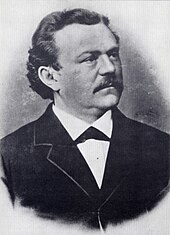Karl Wüst
Karl Wüst (born December 28, 1840 in Heilbronn ; † January 28, 1884 there ) was Lord Mayor of Heilbronn from 1869 to 1884 .
Wüst was born as the son of Martin Wüst from Bonfeld, who was a freight transporter by profession. Wüst attended the Karlsgymnasium in Heilbronn and then began an apprenticeship with Mayer. In 1862 he was deputy council clerk in Stuttgart.
From 1863 he studied administrative science at the University of Tübingen , where he became a member of the student union Landsmannschaft Scotland and completed the first and second service exams by 1867.
He then worked in succession at the Esslingen Regional Office , the Württemberg Ministry of the Interior, the Künzelsau Regional Office and the State Directorate in Stuttgart and for a longer period at the Central Office for Trade and Industry.
In 1869 he was senior actuary at the Stuttgart City Schools Office when, following the rejection of Josef Raur, who was elected to the Heilbronn city council in January 1869, he was offered the position of city council and was elected city school council on May 3, 1869. Wüst had citizenship in Großgartach from his parents , but shortly after his election he acquired citizenship in Heilbronn. He took office on June 15, 1869 and directed the fortunes of the city in an economically extremely prosperous period after the establishment of the German Empire . In 1873, under Wüst, the general building plan for the city was developed by Prof. Reinhard Baumeister , for the implementation of which the city borrowed 500,000 thalers - to be repaid within 35 years - from the Reichsinvalidenfonds for the construction of the waterworks, the slaughterhouse, the sewer system, the high school and other construction projects. The new station was inaugurated in 1874. In the same year Stadtschultheiß Wüst was awarded the title of Lord Mayor by the King of Württemberg . In January 1876, Wüst held the first civil wedding in Heilbronn, and in February of the same year he was one of the founders of the Heilbronn Historical Society , which in future would do well to research its local history.
In the election to the Württemberg state parliament in 1876, Wüst won against Georg Härle in the Heilbronn Stadt constituency . In 1882 he was re-elected unopposed.
In 1878, chain towing began operations on the Neckar , for which Wüst had campaigned for the King of Württemberg in 1875.
Karl Wüst fell ill with a tumor in the chest cavity in late 1883, from which he died in January 1884 at the age of 43. Until the election of a successor, the council clerk Louis Heyd was the administrator. One of Wüst's legacies was that "the town hall officials had achieved a freedom of action that was often not liked by the citizens". The election of a successor to the Mayor of Heilbronn won Paul Hegelmaier , who had made the call “Away with the Vetterleswirtschaft!” His slogan.
Karl Wüst had been married to Marie Elise Wild, the daughter of a Heilbronn doctor, since September 7, 1869. The marriage had four daughters, only two of whom survived the father.
Karl-Wüst-Strasse and the Karl-Wüst-Bridge over the Stuttgart – Würzburg railway line, which opened in 1969, are named after Karl Wüst in the north of Heilbronn (industrial area) . His magnificent tomb with a bronze bust has been preserved in Heilbronn's main cemetery , which was opened during his tenure in 1882 .
photos
literature
- Wilhelm Steinhilber: The Heilbronn city councils since 1803 (V): Lord Mayor Karl Wüst . In: Swabia and Franconia. Local history supplement of the Heilbronn voice . 6th year, no. 3 . Heilbronner Voice publishing house, March 26, 1960, ZDB -ID 128017-X .
- Frank Raberg : Biographical handbook of the Württemberg state parliament members 1815-1933 . On behalf of the Commission for Historical Regional Studies in Baden-Württemberg. Kohlhammer, Stuttgart 2001, ISBN 3-17-016604-2 , p. 1053 .
Individual evidence
- ↑ Heinrich Münzenmaier (ed.): History of Country Team Scotland at Tübingen from 1849 to 1924 . Stuttgart 1924.
- ↑ Quotation from the Hegelmaier report from Interior Minister Schmid to the King of Württemberg in 1892
| personal data | |
|---|---|
| SURNAME | Wüst, Karl |
| BRIEF DESCRIPTION | Lord Mayor of the City of Heilbronn |
| DATE OF BIRTH | December 28, 1840 |
| PLACE OF BIRTH | Heilbronn |
| DATE OF DEATH | January 28, 1884 |
| Place of death | Heilbronn |




